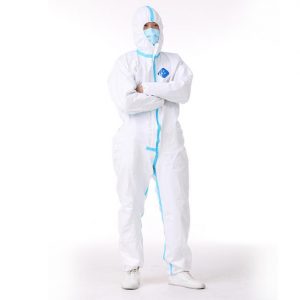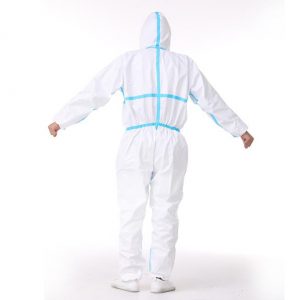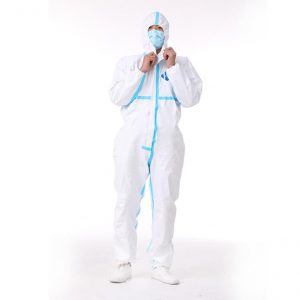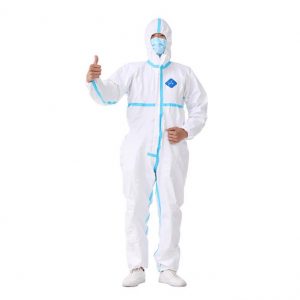



Material: Polypropylene Spunbond Fabric, Heat Sealing Strip
Color: White
Size: XS, S, M, L, XL, XXL
Function: Protection
The cap is designed to fit the face and protect your health. The waist is elastic, suitable for not using body shape, comfortable and not tight. The cuffs are suitable for elasticity, safe protection and easy to use. Heat sealing at the seams of the fabric, waterproof fabric.
Performance requirements:
In addition to the specifications and safety requirements of the material itself, the performance of medical protective clothing mainly includes protection, comfort, physical and mechanical properties and so on.
- Protection
Protection is the most important performance requirement of medical protective clothing, mainly including liquid barrier, microbial barrier and particulate matter barrier.
Liquid barrier refers to medical protective clothing that can prevent the penetration of water, blood, alcohol and other liquids, and has a hydrophobicity of 4 or more to avoid staining clothes and human bodies. Prevent the patient’s blood, body fluids and other secretions from transmitting the virus to the medical staff during the operation.
Microbial barriers include barriers to bacteria and viruses. The blocking of bacteria is mainly to prevent the contact transmission (and reverse propagation) of medical staff to the patient’s surgical wound during the operation. The blocking of the virus is mainly to prevent the medical staff from contacting the patient’s blood and body fluids, and the virus carried in it causes cross infection between the doctor and the patient.
Particulate matter barrier refers to preventing airborne viruses from being inhaled in the form of an aerosol or attached to the skin surface to be absorbed by the body.
- Comfort
Comfort includes breathability, water vapor permeability, drape, quality, surface thickness, electrostatic properties, color, light reflectivity, odor, and skin sensitization. The most important thing is the breathability and moisture permeability. In order to enhance the protective effect, the protective clothing fabric is usually laminated or laminated, resulting in thick and breathable, poor moisture permeability, long-term wearing is not conducive to sweat and heat. The antistatic requirement is to prevent static electricity in the operating room from causing the surgical gown to absorb a large amount of dust and bacteria, which is harmful to the patient’s wounds, and to prevent sparks generated by static electricity from detonating the volatile gas in the operating room and affecting the accuracy of precision instruments.
- Physical and mechanical properties
Physical mechanical properties mainly refer to the ability of medical protective clothing materials to resist tearing, puncture, and abrasion resistance. Avoid tearing and puncturing to provide a channel for the spread of bacteria and viruses, and wear resistance can prevent the flocculation place from providing a place for the propagation of bacteria and viruses.
- Other properties
In addition to the properties listed above, medical protective clothing must have disinfection tolerance, good color fastness to washing, prevent shrinkage, non-combustible, non-toxic, non-irritating, and harmless to the skin.
